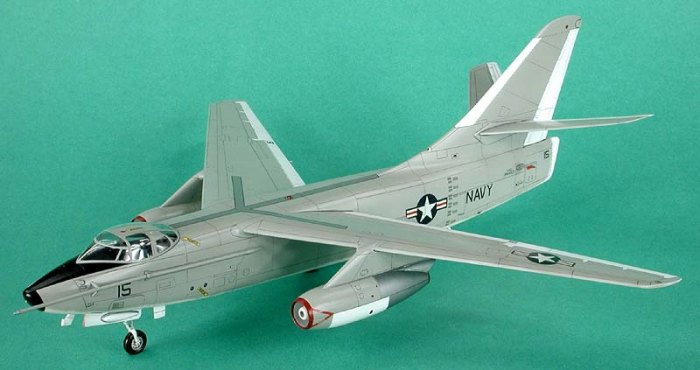
Hasegawa 1/72 KA-3B Skywarrior
|
KIT # |
K 42 |
|
PRICE: |
$39.98 MSRP |
|
DECALS: |
Two options |
|
REVIEWER: |
Bob Laskodi |
|
NOTES: |
Aeromaster decals used |

|
HISTORY |
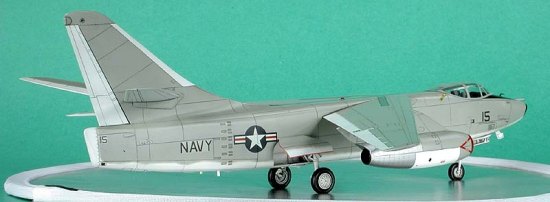 Here is an important
aircraft that you don’t commonly see modeled. Now, I know absolutely
nothing about this crate (except for its huge!). However, IIRC, our
intrepid editor is a big fan of this airplane and is more than welcome to
fill in this section! (Your editor declines as it would just
degenerate into the usual TINS (This is no s**t) sea story, which would
either prove your editor's unusual prowess or gargantuan stupidity so
rather that prove suspicions, this section will be left as is. However,
there is a nice background in the preview which you can access via the
link below)
Here is an important
aircraft that you don’t commonly see modeled. Now, I know absolutely
nothing about this crate (except for its huge!). However, IIRC, our
intrepid editor is a big fan of this airplane and is more than welcome to
fill in this section! (Your editor declines as it would just
degenerate into the usual TINS (This is no s**t) sea story, which would
either prove your editor's unusual prowess or gargantuan stupidity so
rather that prove suspicions, this section will be left as is. However,
there is a nice background in the preview which you can access via the
link below)
|
THE KIT |
The kit is typical Hasegawa; a high quality injected molded plastic with detailed recessed engraving that needs no further introduction. It is what we all have come to expect from Hasegawa, right down to the instructions and decals! If you would like to see what is in the box, then have a peek at this preview.
|
CONSTRUCTION |
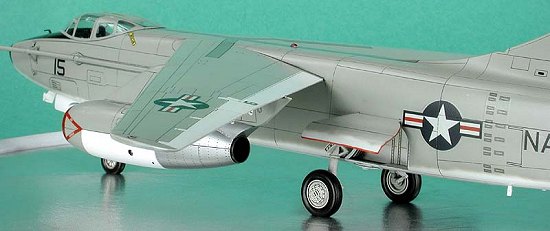 There is absolutely nothing to report here with the
kit, as the Hasegawa kit builds with only a few minor problems. The
cockpit detail is a bit sparse, with decals for the instrument and side
panels, but you really can’t see a whole lot into the cockpit any ways!
Honestly, this kit could almost be built with your “eyes wide shut”, and
there are only two items worth mentioning. Firstly, it is impossible to
build the engines as indicated in the instructions without leaving a seam
down the center, since the fan blades will prevent you from sanding after
joining the engine halves together. I used the Hasegawa Trytool Modeling
Saw Scriber Set (TP-4) to cut off the leading portion of the engine
nacelle, join the front halves together, fill, sand, and paint this
section prior to attaching it back on to the engine. The Hasegawa set is
a re-release of the old Trimaster set, and I strongly advise serious
modelers to take the effort to acquire these as they are absolutely
fantastic. Secondly, the
There is absolutely nothing to report here with the
kit, as the Hasegawa kit builds with only a few minor problems. The
cockpit detail is a bit sparse, with decals for the instrument and side
panels, but you really can’t see a whole lot into the cockpit any ways!
Honestly, this kit could almost be built with your “eyes wide shut”, and
there are only two items worth mentioning. Firstly, it is impossible to
build the engines as indicated in the instructions without leaving a seam
down the center, since the fan blades will prevent you from sanding after
joining the engine halves together. I used the Hasegawa Trytool Modeling
Saw Scriber Set (TP-4) to cut off the leading portion of the engine
nacelle, join the front halves together, fill, sand, and paint this
section prior to attaching it back on to the engine. The Hasegawa set is
a re-release of the old Trimaster set, and I strongly advise serious
modelers to take the effort to acquire these as they are absolutely
fantastic. Secondly, the
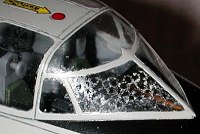 engine pylon join to the wing leaves a few gaps.
These were filled with Mr. Surfacer and sanded smooth. That’s the extent
of the challenges in building this model!
engine pylon join to the wing leaves a few gaps.
These were filled with Mr. Surfacer and sanded smooth. That’s the extent
of the challenges in building this model!
The model was completely assembled, but the landing gear and doors were left off prior to painting. I used a new masking material for the canopy, Glad Press ‘N Seal that showed some promise. A big warning! This stuff leaves residue and use with caution. Fortunately, a product called “Un-Do” removed the residue without damaging the canopy and paint job!
|
COLORS AND MARKINGS |
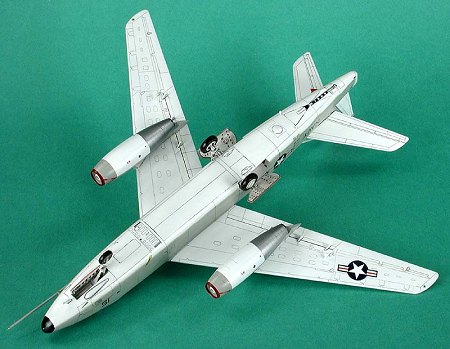 The model was painted entirely with Testor Model
Master (enamel) in Flat White, and Light Gull Gray. First job up was
painting the “hot” section of the engines with SNJ Aluminum, letting it
dry overnight, and then masked with Tamiya Masking Tape. After
airbrushing the entire model Flat White, I stuffed wet tissue paper into
the wheel wells, masked off the white control surfaces with Tamiya
Masking Tape and airbrushed the wings and fuselage with Light Gull Gray.
A light topcoat of Floquil Railroad (enamel) Crystal-Cote was airbrushed
to prepare the flat surface for decaling.
The model was painted entirely with Testor Model
Master (enamel) in Flat White, and Light Gull Gray. First job up was
painting the “hot” section of the engines with SNJ Aluminum, letting it
dry overnight, and then masked with Tamiya Masking Tape. After
airbrushing the entire model Flat White, I stuffed wet tissue paper into
the wheel wells, masked off the white control surfaces with Tamiya
Masking Tape and airbrushed the wings and fuselage with Light Gull Gray.
A light topcoat of Floquil Railroad (enamel) Crystal-Cote was airbrushed
to prepare the flat surface for decaling.
I used a combination of kit decals (mainly stencils) and Aeromaster “A-3 Skywarrior Collection” (72-160) for the build. The Hasegawa decals are the usual stuff, a bit on the thick side, but quite nicely done. However, the Aeromaster decals had a “sheen” on them that made the decals look like they were “silvered” (but it wasn’t silvering). I tried buffing them, coating them with various flattening agents but nothing worked to remove this “sheen”. After drying overnight, I wiped the decals off with Polly S Plastic Prep to remove any residue and after drying I shot a very light coat of Future thinned with Polly S Airbrush Thinner (50:50 mix) over the decals to seal them. For weathering, I chose to accentuate the engraved panel lines and surface detail with a sepia watercolor wash.
|
FINAL ASSEMBLY |
In order to prevent breakage, I left off the landing gear, gear doors, refueling probe, and antennas until after painting/decaling. These all went on with no problems. After a final “leveling coat” of Future (great for hiding those superglue splooges!), I airbrushed Testor Dullcote for the final finish. Remove the canopy masks and you are done with a great model build.
|
CONCLUSIONS |
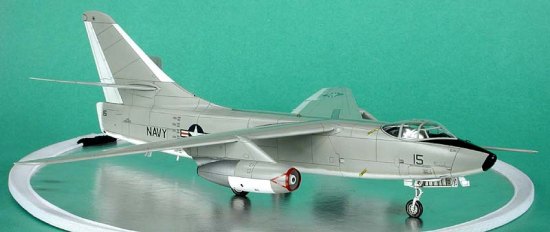 This is a great model of a historically significant
aircraft and Hasegawa is to be commended for their great quality,
engineering, and ease of build. This kit can be built with beautiful
results by a beginning modeler.
This is a great model of a historically significant
aircraft and Hasegawa is to be commended for their great quality,
engineering, and ease of build. This kit can be built with beautiful
results by a beginning modeler.
Now for a personal editorial: I am quite frankly quite distressed by the number of negative comments I see posted on various modeling forums about built models that appear in articles or in the forum. I feel that any completed model (no matter how poorly done, or “wrong”) is a cause for celebration and not for comments like “nice model, but……”. Just because a built model is posted on the internet does not give you a right to criticize it in any way, and I feel it is rude and inappropriate behavior to offer negative comments about any one else’s model (unless they specifically ask). I always welcome positive feedback about my articles and builds (hey, “attaboys” are all I get paid for this article) and if you have a question about a technique I am always more than happy to try and answer your question. But I have no desire to receive e-mails or forum posts about how I was “wrong”.
|
REFERENCES |
I don’t have any! This model was built with specific instructions from a paying client.
Copyright ModelingMadness.com.
If you would like your product reviewed fairly and fairly quickly, please contact
the editor or see other details in the Note to
Contributors.